Roof Rats
INTRODUCTION
The roof rat is the smaller of the 2 commensal rats (Norway rat is larger) and the more common commensal rat in the subtropical and tropical regions of the world. It not only damages/destroys materials by gnawing, eats and contaminates stored food, but it is also of human health importance as a vector or carrier of disease organisms. Roof rats are usually thought to be of southeast Asian origin, and are now worldwide in distribution. In the United States, it is more common in the coastal states, seaports, and the southern third of the country.
Adult with combined head and body length 6-8″ (16-20 cm), tail length 7-10″ (19-25 cm; when pulled over body reaches or exceeds snout), usual weight 5-9 ozs (150-250 g) but up to 12 ozs (340 g). Fur soft, smooth, color usually brown with black intermixed, to gray to black above with underside white, gray, or black. With muzzle pointed, eyes large, ears large (can be pulled over eyes) and almost naked. Tail scaly, uniformly dark, longer than head and body combined. Adult droppings up to 1/2″ (12.5 mm) long, spindle-shaped with pointed ends.
SIGNS OF INFESTATION
Gnaw marks. New gnawings or holes tend to be rough whereas, old gnawings are smooth from wear.
Droppings. Fresh droppings are soft and moist whereas, old droppings are dried and hard; adult roof’s about 1/2″ (12-13 mm) with pointed ends vs Norway’s about 3/4″ (18-20 mm) with blunt ends.
Tracks/footprints. Front foot 4-toed and print is in front of usually longer hind print with 5 toes. Fresh tracks are clear and sharp.
Rub marks or dark, greasy markings on vertical surfaces. Fresh marks are soft, greasy, and easily smeared whereas, old marks are with the grease dry and flaky. Swing marks often present around rafters.
Burrows. Not common, but if present they are shallow. They usually nest in or under dense vegetation.
Runways. Travel routes may not be apparent outside because they may travel along fences or on overhead power or telephone lines. Indoors, they usually move along walls, stacked merchandise, etc. Active runways with greasy appearance, free of dust and cobwebs, with fresh tracks and/or droppings.
Damaged goods. Roof rats prefer fruits, vegetables, and cereal whereas, Norway rats prefer meat, fish, and cereal.
SIMILAR GROUPS
(1) Norway rat (Rattus norvegicus) with blunt muzzle, small eyes, ears small and hairy, tail bicolored and shorter than head plus body, droppings rod-shaped with blunt ends.
(2) Hispid cotton rat (Sigmodon hispidus) with tail about half head-body length combined and less heavy (weight 2 3/4-7 oz/80-198 g), and fur coarse and grizzled, grayish above with mixed buff, black, and whitish below.
(3) House mouse (Mus musculus) with tail about as long as head plus body, smaller (about 1/2-1 oz/14-28 g), shorter (head, body, and tail 5.25-7.5″/6.5-10.2 cm), droppings 1/8-1/4″ (3-6 mm) long, rod-shaped, with pointed ends.
(4) Most native rats and mice with tail hairy, hairs short or long, or if tail almost naked, it is also annulate (appears to be of ringlike segments).
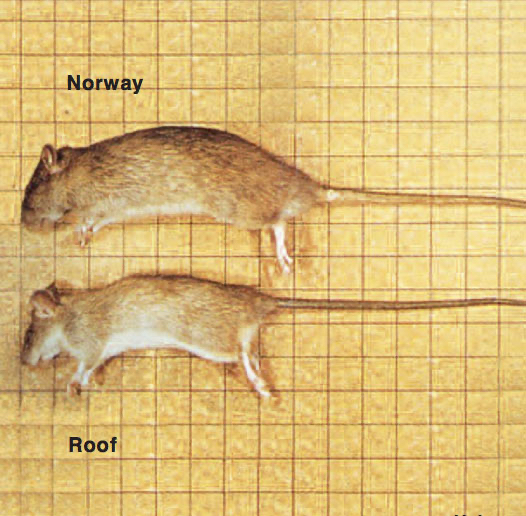
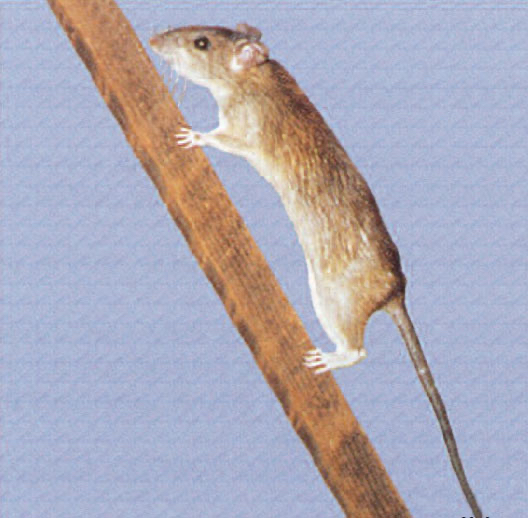
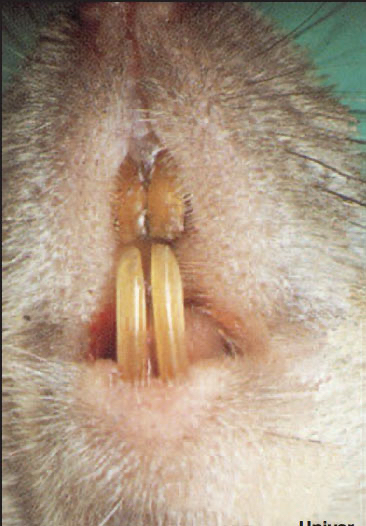
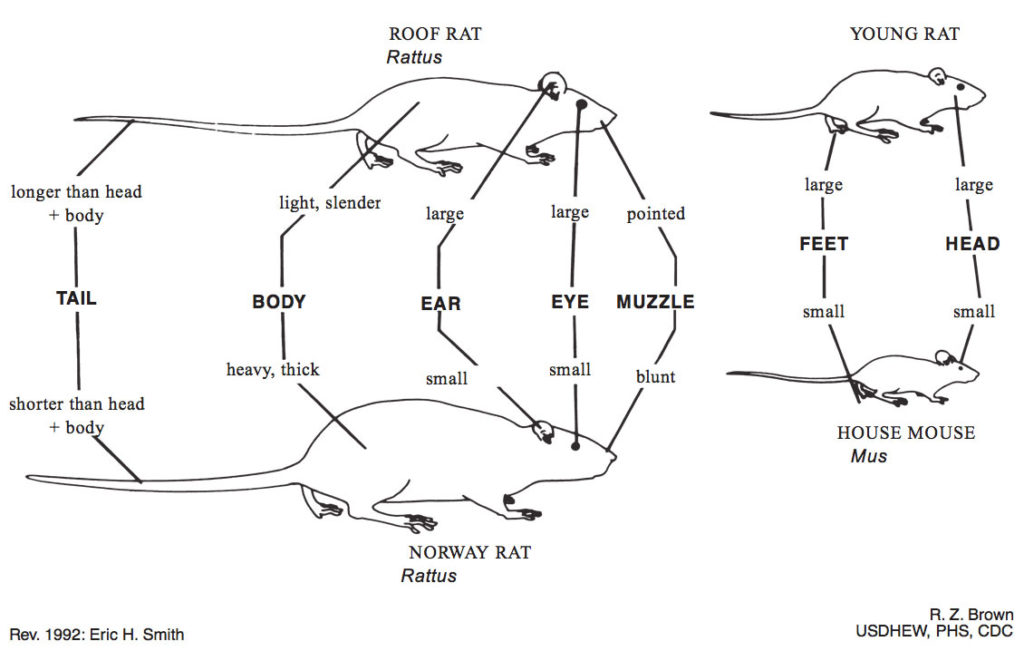
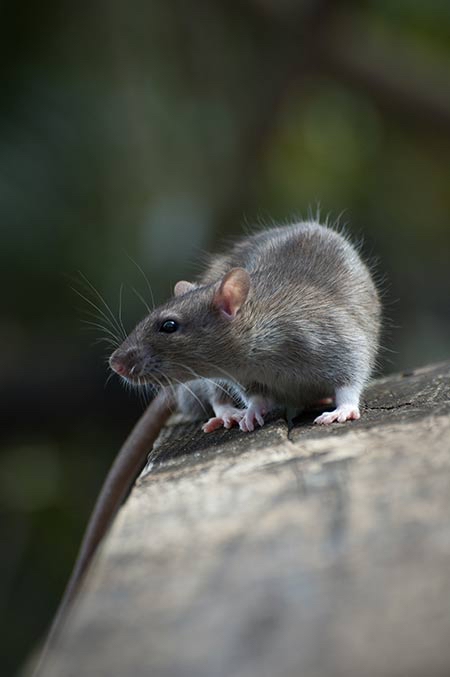
BIOLOGY
Roof rats reach sexual maturity in 2-5 months. Pregnancy lasts an average of 22 days. The young/pups are blind and naked at birth, with hair appearing in about 7 days and eyes opening in 12-14 days. They are weaned at about 3-4 weeks. The average number of litters is 4-6 per year, each containing an average of 6-8 young. Adults on an average live 9-12 months.
They have rather poor vision and are color blind, but their senses of hearing, smell, touch, and taste are keenly developed. Touch is via their vibrissae or long whiskers. They are good runners, excellent climbers and jumpers, and if forced, rather good swimmers.
A roof rat requires 1/2-1 oz (14-28 g) of food and 1-2 oz (30-60 ml) of water each day, with the water often coming in part or totally from its food. This results in about 30-180 droppings and 1/2 oz/3 teaspoons (16 cc) of urine per day.
Historically, bubonic plague has been associated with the roof rat and its fleas, which move from infested rats to man. Fortunately, plague has not been found in rats in the United States for many years. However, plague is found in wild rodents in several south- western states and transmission to humans via infected fleas does occasionally occur. From 1990-2005, CDC recorded a total of 107 cases of plague in the United States, with 81 (76%) being bubonic and 11 (10%) of the total being fatal. In 2006, there were 13 human cases (New Mexico 7; Colorado 3; California 2; and Texas 1). Carriers were primarily rabbits, but also dogs, a wood rat (Neotoma micropus Baird), and a rock squirrel (Spermophilus variegatus Erxleben).
Other transmitted disease organisms include murine typhus via fleas (also probably via droppings and urine), infectious jaundice/leptospirosis/Weil’s Disease via urine in water or food, rat-bite fever via bites, trichinosis via undercooked pork, and food poisoning or Salmonellosis via droppings. Another problem is tropical rat mite dermatitis that is caused by these mites when they feed on humans.
HABITS
Roof rats are primarily nocturnal in habit and colonies contain some members that are very cautious. Although they constantly explore their surroundings, they shy away from new objects and changes. Roof rats prefer to nest in the upper parts of structures, but may be found under buildings as well as occasionally in basements and sewers. Outdoors, they prefer to nest in higher places such as in trees but may occasionally be found in burrows in or under vegetation around the structure. These are social animals but less so than Norway rats. Several nests may be located within a given area. An opening of greater than 1/2″ (12 mm) is required for entry into buildings.
Although they will eat practically anything, roof rats prefer naturally-occuring seeds, nuts, fruits, and berries when in season. If available, they feed on slugs and snails, which may become a large part of their diet. They also feed on insects including American, brown, and smokybrown cockroaches. If they live near waterways, roof rats will feed on fish, shellfish, and other aquatic organisms. Around human structures and livestock operations, they will go after any easily available food. If the eaten food material proves dis- agreeable, they are quick to develop food/bait shyness. Once they find an acceptable/preferred food, rats tend to return time after time.
Roof rats typically feed at dusk and again prior to dawn, although they will forage several times each night and during the daytime. They forage in family groups of up to 10 rats. Roof rats prefer to feed in situations that give them protective cover. They do cashe all kinds of food and seeds in natural cavities or structural voids. Roof rats tend to eat smaller amounts of food in several places, a behavior somewhat between that of a house mouse and Norway rat.
Roof rats do not distribute themselves evenly throughout the grounds/property and/or structure, but prefer to locate in clusters in arial areas or in the upper regions of structures. Once established indoors, roof rats tend to follow the same route or pathway between their harborage and food and/or water sources. Runways along vertical surfaces will usually include dark rub or swing marks on the vertical surface where their fur makes contact. Their runways will be free of debris, and outdoors, the grass will be worn away to the bare soil.
CONTROL
The key to any rat control program is pest identification, sanitation, harborage elimination, and rat-proofing the building. Control is based on the behavioral habits of the roof rat. Some of the more important things to remember are:
Rats defecate where they spend most of their time. Use rat droppings as an indication of where to concentrate the control efforts. Nontoxic tracking powder can also be used to determine where they are most numerous.
Roof rats commonly travel up to 300 ft ( 91.5 m) for food and/or water along established runways. Look for rub/swing marks and clean runways. Place traps or bait stations along runways and against vertical surfaces. Glue boards wired to traveled pipes, rafters, etc. are effective.
Roof rats feed several places, but they feed in groups of up to 10 rats. Place sufficient bait in each bait station for at least 1 meal (stop-feed baits), 2 meals (acute/single-feed baits), or more (chronic/multi-feed baits), but make more placements than for Norway rats.
Some colony members are cautious. Minimal disturbance is desirable when putting out traps and/or bait stations. Prebaiting with unset snap traps or prebaiting with nontoxic bait in bait stations may be necessary. Tie the bait down on the trigger of snap traps with unsented/flavored dental floss.
Roof rats prefer fruits, vegetables, and cereals. Use such high-carbohydrate baits. Bait the center of glue boards and snap traps with such foodstuffs or with a large cockroach with its legs removed.
Rats usually have a water source other than their food if their food has a low moisture content. Liquid baits are particularly effective when their normal water source can be reduced or eliminated.
Glue boards harvest primarily juveniles and adults usually escape. Use glue boards in addition to other methods.
Traps and bait stations are more effective if placed in corners (rats slow down for corners), and along established runways. Droppings will indicate the best placement sites.
Roof rats sometimes nest in ground burrows. Outdoors, gassing (fumigating) rat burrows is extremely effective. Follow label directions and do not gas burrows within 15 ft (4.6 m) of an occupied structure, or burrows that may run under or open into an occupied structure.

